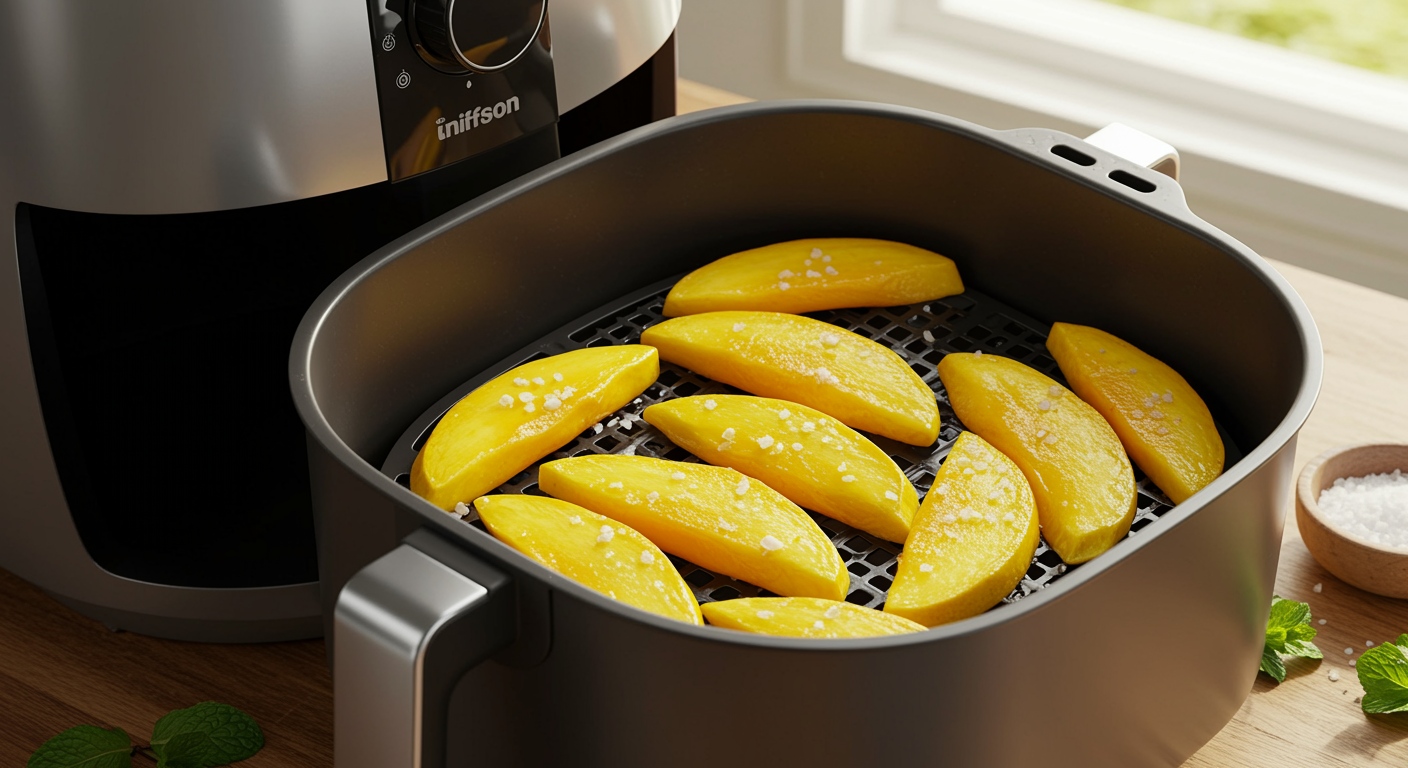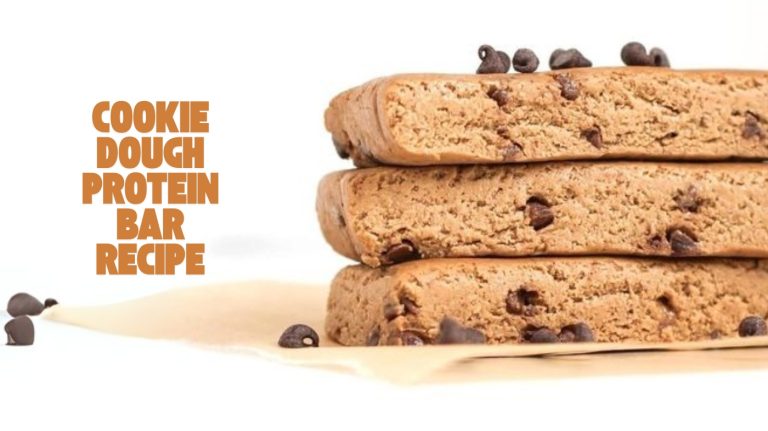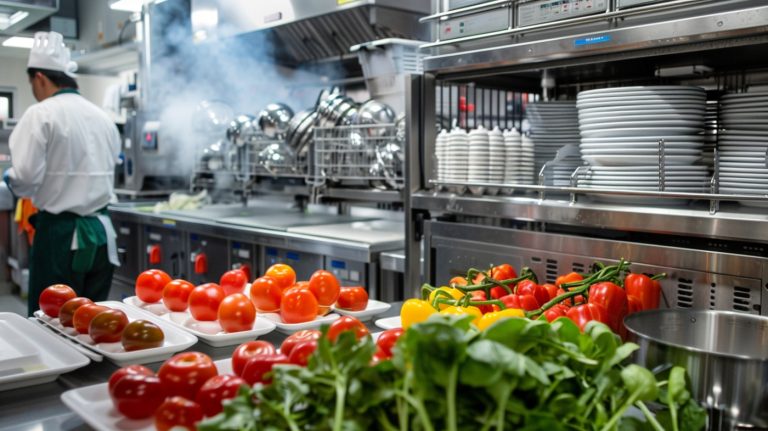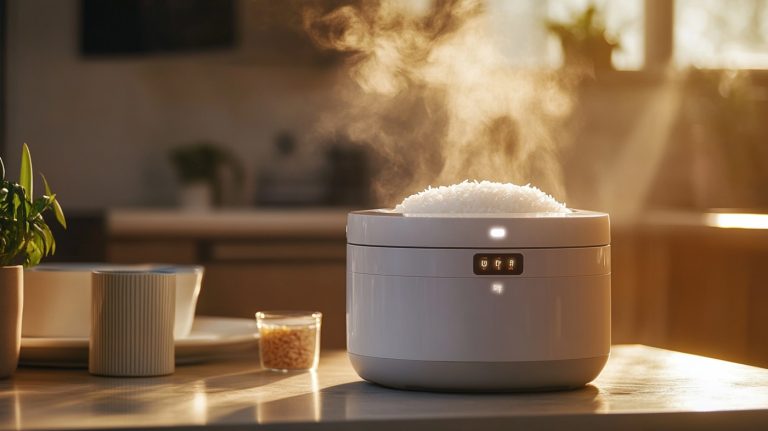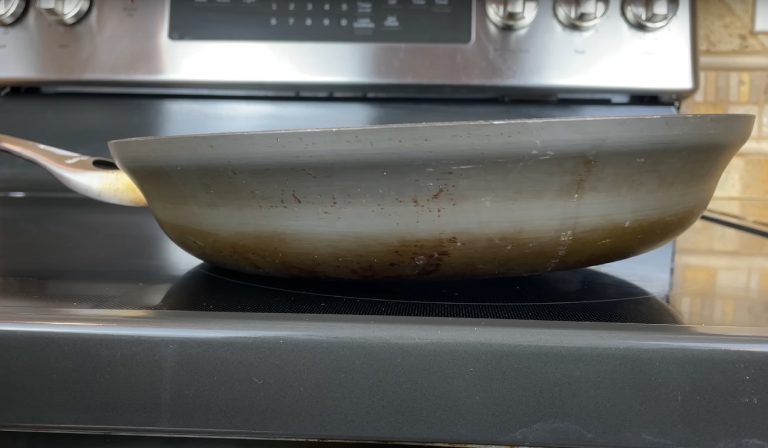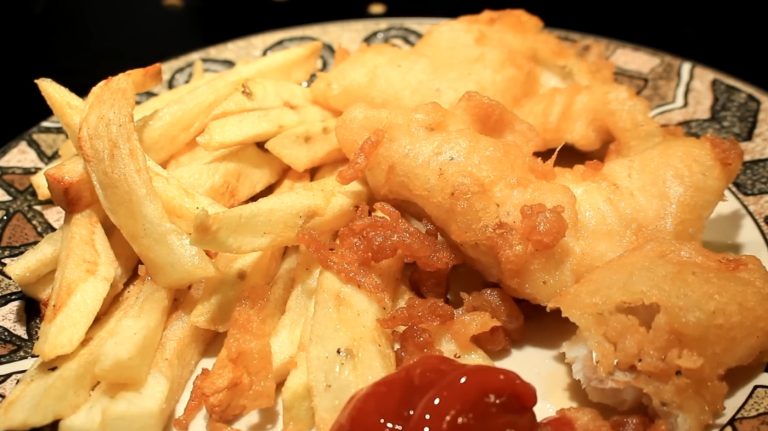How to Dehydrate Mango in Air Fryer? Easy Step-by-Step Guide
To dehydrate mango in your air fryer, start by selecting ripe yet firm mangoes, like Haden or Ataulfo. Peel and slice them evenly into thin pieces for consistent drying.
Preheat your air fryer to 135°F, arrange the mango slices in the basket without overlapping, and dehydrate them for about 2.5 to 6 hours.
Keep an eye on them every 30 minutes to guarantee they reach a leathery texture. There’s so much more to learn about perfecting this process.
Key Takeaways
- Select ripe, firm mangoes, peel, and slice them evenly for optimal dehydration results.
- Preheat the air fryer to 135°F to 140°F for effective moisture removal.
- Arrange mango slices in the basket without overlapping to ensure proper air circulation.
- Monitor the dehydration process every 30 minutes, aiming for a leathery texture and slight pliability.
- Store dehydrated mangoes in airtight containers, keeping them in a cool, dark place for optimal shelf life.
Selecting the Right Mangoes
When you’re ready to dehydrate mangoes, selecting the right ones is essential for achieving the best flavor and texture.
Look for varieties like Haden, Ataulfo, and Kent; they strike the perfect balance between sweetness and firmness. Aim for ripe yet firm mangoes—this prevents mushiness during dehydration. Kent mangoes, known for their refreshing taste during colder months, can also be a great choice when dehydrated.
While color can be misleading, the squeeze test will help you find that gentle softness indicating ripeness. Choose mangoes with minimal blemishes and a sweet aroma near the stem.
Keep an eye out for small brown spots, as these can signal natural sweetness. For added depth, consider Neelam or regional varieties like Totapuri.
Preparing Mangoes for Dehydration
Getting your mangoes ready for dehydration is an essential step to guarantee delicious results. Start by selecting ripe mangoes, then peel and slice them into even pieces, while carefully removing the pit for maximum yield.
This preparation sets the stage for a successful air frying experience that brings out the mango’s natural sweetness.
To ensure the best drying results, use firm, fully ripe mangoes that are unblemished for optimal flavor.
Selecting Ripe Mangoes
To guarantee you achieve the best flavor and texture in your dehydrated mangoes, selecting ripe ones is essential. Here’s what to look for:
| Criteria | Description | Importance |
|---|---|---|
| Firmness | Slightly soft with a gentle give | Indicates peak ripeness |
| Color | Golden yellow or orange-red | Signifies peak sweetness |
| Aroma | Strong, sweet scent near the stem | Indicates delicious flavor |
| Overripe | Too soft | Difficult to slice evenly |
| Unripe | Hard and green | Lacks flavor and sweetness |
Choosing ripe mangoes guarantees you maximize flavor intensity and achieve a pleasing texture in your dried treats. Remember, the right mango can make all the difference.
To enhance your results, consider using uniform thickness in slices for even drying, as this will contribute to a consistent texture in your dehydrated mangoes.
Peeling and Slicing
Peeling and slicing mangoes for dehydration is an essential step that guarantees you get the most out of their natural sweetness and flavor.
Start by scoring the mango skin lengthwise, then peel both sections away. A potato peeler can work, but be cautious as ripe mangoes can be slippery. Choosing firm and ripe mangoes ensures you have the best quality fruit for dehydration.
Once peeled, slice the mango into strips about 1/4 inch thick; this assures even dehydration. Uniform slices are key, as thicker pieces might turn out chewier and require longer drying times.
For safety and consistency, consider using a mango slicer or a sharp knife. Always work on a stable surface and maintain a firm grip to prevent accidents while handling these juicy fruits.
Removing the Pit
Once you’ve peeled and sliced the mango, the next step involves removing the pit, which can be a bit tricky due to the fruit’s slippery texture.
Start by placing the mango stem side down on your cutting board for stability. If you have a mango cutter, use it to separate the pit efficiently. If not, gently cut around the pit with a sharp knife, taking care not to slip.
Once the pit’s removed, chop the remaining fruit into manageable pieces. Remember, mangoes can be fragile, so handle them with care. Dehydrating mango can also help you enjoy the fruit year-round, even when it’s out of season.
Don’t forget to utilize the fruit scraps around the pit; they can be dehydrated or used in other recipes, reducing waste while adding flavor.
Setting Up Your Air Fryer
To get your air fryer ready for dehydrating mango, start by setting the right temperature, usually around 135°F for ideal results.
Next, arrange your mango slices evenly in the basket, making sure they don’t overlap to allow for proper air circulation. This simple setup is essential for achieving that perfect, chewy texture you’re aiming for.
Additionally, ensure proper air circulation around the appliance to prevent uneven drying and enhance the dehydration process.
Temperature Settings Explained
When it comes to dehydrating mangoes in your air fryer, understanding the right temperature settings is key to achieving perfect results.
Aim for a suitable range between 135°F to 140°F (57°C to 60°C). This precise temperature allows for effective moisture removal while retaining flavor and nutrients.
Most air fryers let you adjust the temperature easily, making it simple to get consistent results. Additionally, dehydrators are safe if placed in a ventilated area, ensuring that the air circulation is optimal during the drying process.
Compared to traditional dehydrators, air fryers can greatly speed up the dehydration process thanks to their efficient heat distribution and air circulation.
Additionally, utilizing the cooking guide available on the official Philips site can enhance your drying technique. Always check your air fryer’s manual for specific temperature guidelines and safety precautions.
Proper Slice Arrangement
Achieving perfectly dehydrated mango slices hinges not just on temperature settings but also on how you arrange those slices in the air fryer.
Start by cutting your mango into uniform 1/4 inch thick slices to guarantee even drying. After washing and patting them dry, place the slices in a single layer within the air fryer basket, avoiding any overlapping.
This setup allows for ideal air circulation, which is key to consistent dehydration. Additionally, dried mangoes retain their nutritional values and provide a healthy snack option.
If your fryer has multiple trays, use them to increase your batch size, but always keep space between slices. Rotate trays occasionally to promote uniform drying, and monitor the progress every 30 minutes to prevent any over-drying.
Dehydration Process Overview
Dehydrating mango in an air fryer is a straightforward process that transforms fresh, ripe fruit into a delightful snack.
To achieve perfectly dried mango, follow these essential steps:
- Temperature Matters: Set your air fryer between 120°F and 160°F for ideal results.
- Time is Key: Expect dehydration to take 2.5 to 6 hours, depending on slice thickness. The dehydration time is significantly reduced when using an air fryer compared to traditional methods.
- Uniform Slicing: Confirm your mango slices are consistent in thickness to promote even drying.
- Freshness Counts: Choose ripe mangoes for the best flavor and texture.
Monitoring Drying Progress
As you commence on the journey of dehydrating mango, keeping a close eye on the drying progress is crucial for achieving that perfect snack.
Check the slices for a leathery texture and slight pliability; they should feel dry, not sticky. Remember, even drying is key, so rotate the slices or shake the basket to guarantee uniformity.
Schedule your checks every 30 minutes after the first hour—this helps you catch any uneven drying early. If some slices seem done while others aren’t, remove the dry ones to prevent brittleness.
Periodically squeeze the slices; ideal dryness means no moisture will be detected. This vigilance guarantees your mango slices are safe, flavorful, and ready for storage.
Additionally, if you’re using an air fryer with dehydrator settings, it can help optimize the drying process for consistent results.
Factors Influencing Dehydration Time
When it comes to dehydrating mango, several key factors can markedly influence the time it takes to achieve that perfect texture.
Understanding these elements can make the process smoother and more satisfying:
- Mango Variety: Different types have unique moisture levels.
- Slice Thickness: Thicker slices take longer, while thinner ones can turn brittle. Thin slices are ideal for achieving optimal dehydration.
- Temperature Stability: Maintaining a consistent low temperature guarantees even drying.
- Humidity: High humidity slows down dehydration, making it a challenge.
Storing Dehydrated Mangoes
After you’ve perfected the dehydration process, properly storing your dried mangoes is key to maintaining their delicious flavor and chewy texture.
Keep them in a cool, dark place like a pantry or cupboard, ensuring the temperature stays below 21°C (70°F) to prevent moisture absorption. Use airtight containers—sealed jars, heavy-duty plastic bags, or vacuum-sealed bags work best to keep out air and humidity.
Additionally, the shelf life of dried mango can be significantly extended when stored under optimal conditions. If you choose to refrigerate, seal them well and store them away from strong-smelling foods.
For long-term storage, freezing in airtight containers can extend shelf life up to 12-18 months. Always label your containers with the date for easy tracking, and remember to thaw them slowly in the fridge for best texture and flavor.
Frequently Asked Questions
Can I Dehydrate Frozen Mangoes in an Air Fryer?
You can dehydrate frozen mangoes in an air fryer, but it’s not the best option. Frozen mango tends to have excess moisture, which can lead to inconsistent texture and chewiness.
If you decide to go ahead, make sure to fully defrost and dry the mango slices before placing them in the air fryer. For better results, consider using fresh mangoes, as they’ll provide a more flavorful and consistent outcome.
What Can I Do With Leftover Mango Pits?
Mango pits provide plenty of potential! You can create infused liquor by simmering them in vodka for a 24-hour flavor infusion. If you’re feeling crafty, try using the pits in traditional dishes like mole sauce for a unique twist.
For little ones, these pits can serve as safe, natural teethers that delight with their sweet texture. And if you’re green-thumbed, plant them to grow your very own mango tree.
Is It Necessary to Soak Mango Slices Before Dehydration?
No, you don’t need to soak mango slices before dehydration. Skipping the soaking process helps your mangoes dry evenly, maintaining a crunchy texture.
Fresh, ripe mangoes work best, so slice them about 1/4 inch thick. Arrange the slices in a single layer to guarantee good airflow.
If your mangoes are too soft, you might need to extend the drying time, but overall, soaking isn’t necessary for great results.
Can I Mix Mango With Other Fruits for Dehydration?
You might worry that mixing mango with other fruits could ruin its unique flavor, but it actually enhances your dehydrating experience.
Combining mango with fruits like pineapple or berries creates a delightful medley of sweetness and tanginess. Just make sure the fruits share similar drying times and thickness. When done right, you’ll enjoy a vibrant, nutritious snack that’s perfect for trail mixes or toppings.
How Do I Know When Dehydrated Mangoes Are Spoiled?
To know when dehydrated mangoes are spoiled, look for visible mold, discoloration, or crystallization. Feel the texture; if it’s too hard or mushy, that’s a red flag. Trust your nose—any off odors or unusual tastes signal spoilage.
If you notice stickiness or clumping, moisture may have compromised the fruit. Proper storage can help maintain quality, so always check for these signs before enjoying your dried mango.
Dehydrate Mango in Air Fryer and Enjoy a Sweet, Healthy Snack
To sum up, dehydrating mangoes in your air fryer is not only efficient but also preserves their vibrant flavor and nutrients. You might’ve heard that air fryers can’t handle dehydration, but that’s simply not true—these versatile appliances can work wonders when used correctly.
So, grab those ripe mangoes, follow the steps, and enjoy the sweet, chewy goodness of homemade dehydrated mango. It’s a fun, delicious way to snack smartly while embracing your kitchen’s potential.

